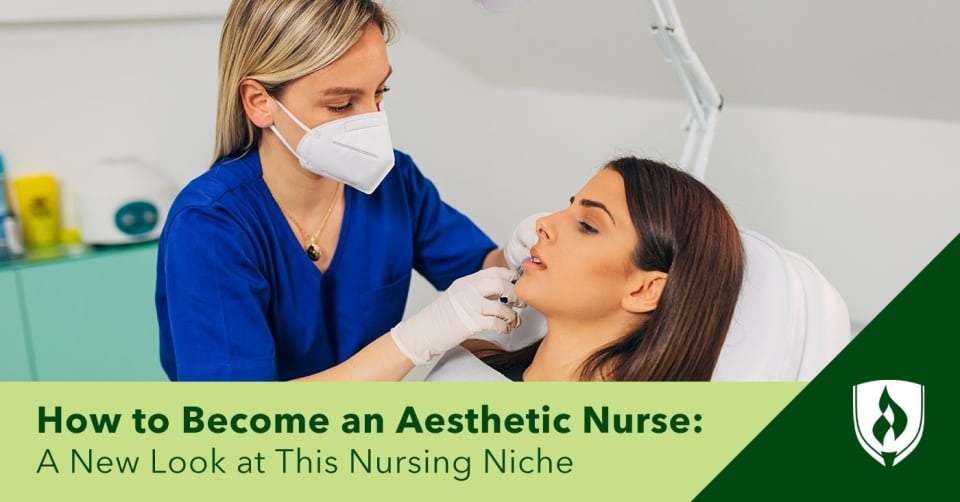Aesthetic nurses go by many names. You may see them referred to as cosmetic nurses or even nurse injectors. While there may be small differences in the names, the core of what they do in their daily work remains the same—helping patients look and feel their best via cosmetic procedures.

While this niche line of nursing work is certainly a departure from the life-and-death stakes of working in a critical care nursing role, it still depends on skilled and safety-conscious nursing professionals. At face value, it’s an alluring field for some, but there’s a lot to know about aesthetic nursing before you dive in, as it is a fairly significant departure from what you’ll find with most nursing roles.
We’re here to provide expert insight into the role of an aesthetic nurse and what it takes to become one.
What does an aesthetic nurse do?
Aesthetic nurses consult with patients and perform examinations regarding elective procedures. During these consultations, they help patients determine what body changes they would like and suggest options for procedures that can help them reach these goals. There are many procedures aesthetic nurses perform. Some of the most common aesthetic elective procedures include:
- Injectables: Injectables can have a wide range of effects. Neuromodulators (like Botox®) treat fine lines and wrinkles by relaxing the underlying muscle. Dermal fillers, like Juvéderm® and Restylane®, can reduce wrinkles by adding volume to areas like the lips or sagging areas like the hollow of the cheeks or under the eyes.
- Laser and light treatments: Lasers can treat small imperfections like wrinkles, scars and warts. Others use heat to promote collagen production. Lasers are also used for tattoo removal, unwanted hair, spider veins or redness.
- Non-invasive body contouring: There are several ways to remove excess fat from the body. Low-level laser therapy uses cold laser therapy to target and break down adipose cells. Clinicians can also use ultrasound therapy to direct sound waves toward adipose cells and disrupt them or use radiofrequency therapy to destroy adipose cells through heat. Recontouring can also be done through dermal fillers in some areas.
- Skin treatments: These are used to improve the overall appearance and health of the skin. Treatments include chemical peels, dermaplaning, microdermabrasion and microneedling.
Not all aesthetic nurses perform all of these treatments. It depends on the clinic and their capabilities. Aesthetic nurses can work in private practices, hospitals, dermatology offices and medical spas.
Many nurses new to aesthetics start with skin treatments, body contouring and laser/light procedures before getting trained in administering injectables, which takes an advanced knowledge of anatomy and the nuances of working with different injectables.
In addition to performing these procedures, aesthetic nurses also do a lot of education to help patients manage their expectations and care for themselves pre- and post-treatment.
Plastic surgery vs. aesthetic nurse
When examining the work of an aesthetic nurse, it’s important to make a distinction between these nurses and the nurses who work in elective plastic surgery centers. Both roles ultimately strive to help their patients feel at ease in their own skin, but there are significant differences. The easiest way to see this distinction is in the services the different specialties provide.
Aesthetic clinics focus on non-surgical solutions and other in-office treatments to enhance the patient's appearance.
Plastic surgery nurses specialize in caring for patients who undergo cosmetic surgical procedures like liposuctions, breast augmentation/reductions, face and neck lifts, hair transplants or gender reassignment procedures. This means that a lot of their work is centered around procedures, which include pre- and post-op care. They may also function as the circulating nurse in the operating room.
What you should know about aesthetic nursing
1. You’ll help people feel better—but in a different way
Nursing is a helping profession, but it manifests differently when working in aesthetics. For some nurses, working in aesthetics can feel like a relief compared to a hospital setting, where patients are often worried, frustrated and itching to get out. They’re usually in pain or processing a new diagnosis, which can mean helping patients work through nerves or anger.
On the other hand, patients are typically much more enthusiastic for aesthetic procedure appointments. While they may be a little anxious, they’re excited about the changes they’re seeing, which means they’re excited to see you.
Maintaining a positive self-image is a challenging subject for almost everyone, so helping patients feel better about themselves can be an incredibly rewarding experience.
“I love that I get to enhance a client’s natural beauty, increase their self-confidence and make someone feel better about themselves,” says Melanie Speed, nurse practitioner and owner of Flawless Aesthetics Med Spa.
She recalls a mother who brought her son in who was being bullied at school for a large bump on his nose. Speed was able to perform a nonsurgical nose treatment on him. When she handed him the mirror, he burst into tears and hugged Speed. He told her she changed his life by fixing his biggest insecurity.
“Sometimes, when I’m having a difficult day, I think about that experience, and it reminds me why I do what I do,” says Speed.
While patients’ reactions can be rewarding, so can the work itself. Aesthetic nurses use their creativity to balance beauty and medicine. “I found that aesthetics allowed me to use that love for art and symmetry along with my medical skills,” says Speed.
2. Elective procedures are still consequential
While working in aesthetics doesn’t carry the life-and-death weight that nurses in other specialties carry on a daily basis, there can be huge repercussions for any mistakes made during an aesthetic procedure.
While aesthetic nurses can boost patients’ self-confidence, they can also disappoint patients with unintended effects of injections like a dropped eyebrow or eyelid if a neuromodulator is over-injected or migrates. Vessel occlusions are another unfortunate possibility that occur when an artery is accidentally injected with a filler or neuromodulator. It can also occur when vessels or arteries are compressed after injection.
A patient’s appearance is nothing to take lightly, and hugely consequential mistakes can happen during aesthetic procedures. That’s precisely why skilled healthcare professionals with specialized training are trusted to take on this work.
3. Social media will be essential to your job
Since aesthetic procedures are elective and generally paid for out-of-pocket, aesthetic treatment providers are also often working in a form of consultative sales—and that requires drumming up interest. For many aesthetic nurses, maintaining a strong social media presence is a critical (and time-consuming) tactic.
“People want to see your work before they can trust you with their faces,” says Speed.
Aesthetic nursing has found a home on social media. Image-driven channels are wonderful places for aesthetic nurses to share patients’ results and answer questions about treatments and products.
But social media can be a double-edged sword as well. Speed has watched how increased social media filters and image editing within the past few years have heightened some patients’ unrealistic expectations. Some want to look just like a certain celebrity when that’s just not possible. While managing those expectations can be a challenge, Speed says she does her best to highlight her patient’s unique features. “As an aesthetic nurse, my job is to enhance my client’s individual beauty,” says Speed.
Additionally, some patients’ perceptions of themselves go behind only social media’s influence. Patients may be suffering from body dysmorphic disorder. Aesthetic nurses may have to have difficult conversations with these patients and deny a procedure if they believe it will cause more harm than good.
4. You’ll always be learning—and teaching
There are certifications for nearly every procedure an aesthetic nurse does. Taking courses to stay on top of new treatments and studies is key to being an effective aesthetic nurse. Being certified in certain procedures can help boost your credibility as well.
In addition to learning, you’ll always be teaching. Patients can come into their appointments with misinformation from the internet or social media. It’s your job to help them get the best results possible. This could mean teaching them about a different treatment than the one they originally asked for to give them the results they really want.
5. It can be a very tough field to get established in
Unlike many nursing roles, there’s not exactly a shortage of qualified candidates looking to get started in aesthetic nursing positions, and some regions of the country have far more opportunities than others. This is a role that’s likely to have a lot of competition and may be a challenge to break into. Additionally, clinics and medical spas can be very picky when it comes to hiring—including having high expectations for their staff’s physical appearance.
Given the potential barriers to entry, it may be best to evaluate your career path—particularly if other types of nursing roles are not of interest to you. Ask yourself: If an aesthetic nursing role never materializes, will you be okay with working in a plastic surgery clinic, hospital or other more traditional bedside settings? If not, this may not be the ideal path to a career in aesthetics.
6. Regulations for aesthetic nurses vary
Healthcare is no stranger to complex and critical regulations that, if not adhered to, can put nursing or medical licenses at risk. The rules governing medical spas, how services are marketed and the training or education needed to provide specific treatments can vary from state to state. Given the investment needed to earn licensure, it’s important for anyone working in aesthetics to have a clear understanding of what is or isn’t acceptable in the state they choose to practice.
While this is true for all licensed healthcare professionals, aesthetics and medical spas can sometimes fall into tricky-to-navigate legal scenarios, so it’s advisable to proceed with caution.
7. There are opportunities for growth
One of the best things about nursing is the opportunity for growth in any specialty. Like with other specialties, an RN can become a nurse practitioner (NP) and work with a broader scope of practice.
In states that authorize full-practice authority for nurse practitioners, aesthetic NPs may have the opportunity to open their own aesthetics practice. While this is certainly a huge undertaking, as there’s a lot of the “business” side of healthcare to navigate, this option allows NPs to employ their own teams and build their own practice.
Speed says she has advanced her career by becoming an educator for other aesthetic professionals, including opening her own training program. She also plans to open additional medical spa locations in the future.
Even setting aside entrepreneurial ambitions, an aesthetic professional can continue to advance by mastering new aesthetic procedures and staying on the cutting edge of new developments in aesthetic medicine.
How to become an aesthetic nurse
The first step on the road to becoming an aesthetic nurse is to become a registered nurse (RN). To become an RN, you’ll need to earn a degree—either an Associate's Degree in Nursing (ADN) or a Bachelor of Science in Nursing (BSN)—and meet all other requirements for state licensure, including passing the NCLEX-RN®.
Additionally, aesthetic nurses may choose to advance their education and become a nurse practitioner. This requires completion of either a Master of Science in Nursing Nurse Practitioner program (MSN-NP) or a Doctor of Nursing Practice (DNP) program for nurse practitioners. Aspiring aesthetic NPs will typically pursue a broad NP specialty focus like adult-gerontology or family nurse practitioner (FNP) before branching out into aesthetic practice.
No matter the education path, you’ll want to look for opportunities to get your foot in the door with aesthetic professionals and start training on any aesthetic procedures you can. Look for shadowing opportunities and consider joining state and local aesthetic nursing organizations as soon as possible. Speed recommends nursing students and new nurses attend as many aesthetic training seminars as they can and do so often. This will help them meet professionals in the field and learn more about what the job might look like for them.
A big aspect of this role is your personality, bedside manner and ability to consult with patients well, so aspiring aesthetic nurses will benefit from putting this skill set on display whenever possible. Refining your communication skills can certainly help you make a strong impression on employers.
Experience in related roles can be a big help as well. Working as a nurse in plastic surgery clinics, ear nose and throat (ENT) clinics and other ambulatory settings can be an excellent starting point for aspiring aesthetic RNs.
Do I need an aesthetic nurse certification?
While there are many certifications available for individual treatments, there is one broad aesthetics-focused professional certification you may want to consider pursuing: the Certified Aesthetic Nurse Specialist credential from the Plastic Surgical Nursing Certification Board. While this isn’t necessarily a requirement, it can help demonstrate your expertise and dedication to the field.
Is aesthetic nursing for you?
Working in aesthetics is a unique way to use your nursing skills and help patients feel like themselves. Whether you’re a skincare buff or fascinated by fillers, there’s potentially a place for you in aesthetics nursing.
If you’re ready to start down your path of becoming a registered nurse, begin with our article “How to Become an RN Fast: 3 Potential Paths to Pursue.”
1Bureau of Labor Statistics, U.S. Department of Labor, Occupational Outlook Handbook, [information accessed October 2022], www.bls.gov/ooh/. Information represents national, averaged data for the occupations listed and includes workers at all levels of education and experience. Employment conditions in your area may vary.
Botox is a registered trademark of Allergan, Inc.
Juvéderm is a registered trademark of Allergan Holdings France.
Restylane is a registered trademark of Galderma Holdings S.A.
NCLEX-RN is a registered trademark of the National Council of State Boards of Nursing, Inc.




